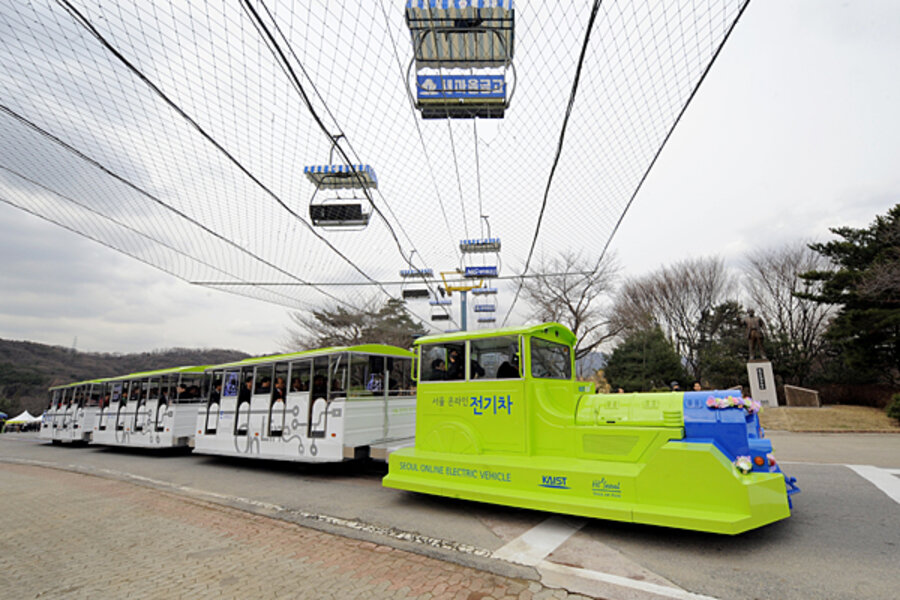Korea OLEV concept vehicle sees the future, and it's magnets
Loading...
| Seoul, South Korea
There once was a time when horseless carriages were jeered on city streets. Suh Nam-pyo, president of the Korea Advanced Institute of Science and Technology (KAIST), invokes that image as he introduces another technological breakthrough: a motor vehicle that consumes no fuel, gets electrical charges while in motion without plugging in -- and then goes “anywhere.”
"Many people said it couldn’t be done," says Mr. Suh, for 35 years a professor at the Massachusetts Institute of Technology in Cambridge. "In spite of many negative comments, we have shown it is a viable concept."
Suh introduced OLEV, the "on-line electric vehicle," on a circular drive within the spacious wooded confines of Seoul Grand Park, a zoo and amusement area on the southern fringe of the capital. The technology powers a trolley train of three or four open cars, a converted kiddy ride. Without having to travel on a fixed route, it runs without stopping. A bar code on a computer screen on the front seats lets passengers know when an underground cable, connected to an ordinary electric grid, is recharging the battery via powerful magnets.
The magnetic field is so strong that the train's battery takes the charge without the slightest sign of movement. No part of the train other than the wheels comes closer than about 7 inches to the ground – a difficult technological achievement considering that the power is passing through a layer of air.
The wheels, the only contacts with earth, move the vehicle along, noiselessly, at a maximum speed, in this early version, of 30 or 40 mlles per hour..
“The battery will power the cable when the electrical cable is absent,” says Suh. “We feel this is the way to transform the transportation industry, not only automobiles but other forms of transportation.”
Not an easy sell
BUT OLEV is not all that easy a sell to government leaders and corporate officials.
“We think it’s got great potential,” says Oles Gadacz, spokesman for Hyundai Motor, after consulting Hyundai engineers, “but the investment would be
The way for OLEV to go, he believes, is first to prove itself in buses -- a project that Seoul is considering on an experimental route as early as next year on a highly controlled, experimental version.
“Perhaps it might have the advantage of trolley cars in operating on a fixed route,” he says, but Hyundai isn’t ready yet to put money on it.
Lack of funds
Such doubts explain why KAIST, a state institution, has had to settle for relatively small appropriations of around $25 million a year for research and development alone. The project, though, does have qualified support from major manufacturers. Hyundai Heavy Industries, the world’s largest manufacturer of merchant vessels, with long experience turning out electrical engines for ships, made the equipment needed to convert the train from diesel to electric at Seoul Grand Park.
OLEV will come of age gradually, say those close to the project.
“We are negotiating,” says Park Byun-gun, a professor at KAIST. “For this system, we are way ahead of others” – though he acknowledges that Nissan, the large Japanese motor vehicle company, is also working on its own version.
What is unique about OLEV, he notes, is that it can recharge while moving -- a feat that Nissan has yet to accomplish and that may take several hours on the hybrid vehicles in operation today. Moreover, he says, the batteries in OLEV are far lighter than those used in hybrids.
Cho Dong-ho, project director, has no illusions about the long road ahead when it comes to weaning the world from the gasoline combustion engine but believes actually “most people want to use electric cars.”
The problem, he says, is that the hybrid cars now on the market weigh too much, cost too much, and take far too long to recharge – generally about four hours.
Current hybrids, he says, run on “evolutionary electrical systems” – an in-between stage that he believes will eventually disappear.
But how soon might the OLEV be in routine worldwide use?
“About 20 or 30 years,” Mr. Cho predicts.
Suh In-soo, an engineer at KAIST, believes OLEV is fast smashing resistance to acceptance. “This concept has been around for two to three years,” he says. Manufacturers and buyers alike, he predicts, will soon see OLEV is “very cost competitive,” with vehicles, if produced in large quantities, likely to go for one-half to three-fourths of the competition's price





